Playing Pitch Strategy SPD
Chapter 5 - Findings for Sub-areas
5.1 This chapter considers qualitative findings at the sub-area level.
5.2 Qualitative findings are based primarily on the comments made through the questionnaire-based survey, but are not limited to matters raised through this. Four general areas will be scrutinized:
-
Quality of the playing pitches and ancillary facilities;
-
Availability and bookings;
-
Accessibility, and
-
Access to other outdoor sports facilities.
5.3 As suggested in the Sports England guidance, it is important to look at the whole picture in terms of what outdoor sports facilities the District provides. Formal sport is just one use of open space, an integrated approach should be adopted to reflect the formal requirements for playing pitches into other informal uses of open space.
5.4 Participation in sports that are regarded as informal uses include bowling greens, tennis courts yacht clubs, etc, has social and health benefits. Other open spaces such as children’s play areas, kick-about areas and allotments are also some important assets of the District which should not be neglected.
5.5 Where issues have been identified within each section of this chapter, recommendation to remedy these issues are presented in the next chapter.
(1) Findings for the Rayleigh Sub-Area
5.6 12 questionnaire responses have been received from the clubs based in Rayleigh. Comments were received from four football clubs and one cricket club.
5.7 In terms of football, two comments received were related to the quality of the playing pitches and ancillary facilities and another one raised an issue about the management methods of a pitch.
5.8 For cricket, although it shows from the current PPM (Table 4.7) that there was no deficit in 2008/09 in general, there was a shortage of 1.2 adult pitches and 0.7 junior pitches on Saturdays PM and Sundays AM respectively in Rayleigh.
5.9 The only cricket club that responded to the questionnaire suggested provision of a new cricket pitch for Rayleigh.
(1) Quality of the playing pitches and ancillary facilities
5.10 In question 17 of the questionnaire, we asked the clubs to fill in three of the best pitches they have played. Two clubs felt Fairview Playing Field in Rayleigh was one of the best three pitches they have played in 2008.
5.11 In contrast, four pitches in Rayleigh were selected more than once in response to question18 “one of the three worst pitches you have played on this season”. Though Fairview Playing Field was selected twice as being one of the best, it was also selected four times as one of the three worst pitches clubs have played in 2008.
5.12 The other three pitches in Rayleigh which were selected by respondents as one of the worst include they had played on were: Vincent Valley Playing Fields on Trenders Avenue (selected five times); Land off Rawreth Lane Playing Pitch (selected three times) and John Fisher Recreation Ground (selected twice).
5.13 A football team training in Rawreth Lane Playing Field pointed out the surface of the pitch is uneven; and some improvement work such as the erection of fences and the cutting back of the hedgerow could be carried out to avoid losing balls in the match/ training.
5.14 One football club commented in the questionnaire that their pitches are solely maintained by voluntary labour at the expense of the club.
5.15 Four footballs clubs believed that lack of appropriate local facilities (Q.10) was one of the problematic issues for them. Among those clubs who felt that this was the case, two were sited on John Fisher Recreation Ground, one was on Rawreth Lane Playing Field and another one on King George V Playing Field.
5.16 The cricket club that responded also felt that there was lack of appropriate local facilities for their 5th and 6th team. In addition, there was lack of voluntary assistance to back the positions in the club.
Availability and bookings
5.17 Looking at the sub-area level, all of the undersupply for mini and junior football pitches have fallen on Sundays AM and both Sundays AM and PM, respectively; while there was a high number of surpluses on senior pitches on a Sunday.
5.18 Senior pitches to be redesignated as mini/junior pitches or to be used as mini pitches at peak time could help to ease the pressure on mini and junior pitches in the area.
5.19 To assess the adequacy of the current provision, one of the considerations would be how many of the clubs based within the District’s settlements train outside the area, and vice versa. If too many of the teams have to travel outside the settlement for their training, this may imply that they are experiencing difficulty to find a pitch within their locality.
5.20 In 2008/09, there were two clubs based in Rayleigh who had to travel outside the settlement for some of their training – training venues for the two clubs were located in Leigh-on-sea and Hockley.
5.21 Poor communication is another issue mentioned by a team playing at John Fisher playing field. They also believed that changes to maintenance and administration methods represented a step backward in terms of quality.
Accessibility
5.22 No issues were raised from any clubs based in Rayleigh in relation to accessibility.
Access to other outdoor sports facilities
5.23 An Open Space Study was published in January 2010. It consists of a full audit of all open space sites within the District. These included both formal and informal sports provision in the open space.
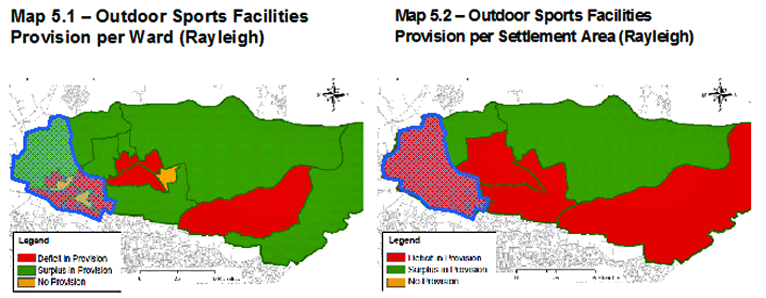
5.24 Many of the open spaces identified in this assessment have a multifunctional use. According to the Open Space Study, there are 13 outdoor sports sites in the Rayleigh area. Within these are 10 football fields, and there are three cricket grounds, a tennis club and a golf range.
5.25 Although sports fields identified in the Open Space Study are different from those in the Playing Pitch Strategy, the graphical representations illustrate in the Open Space Study still provides a picture of the surplus/ deficit of provision in the District.
5.26 Map 5.1 shows outdoor sports facilities provision per ward. Only provision in Downhall and Rawreth ward was in surplus. Five wards in the area were in deficit, and the Grange and Rayleigh Central wards have no provision within the wards, albeit these are two relatively small wards and having good connectivity to other wards in Rayleigh.
5.27 Map 5.2 indicates insufficient outdoor sports facilities in Rayleigh in general.
Findings for the Hockley Sub-Area
5.28 Three football clubs from Hockley returned the questionnaire.
Quality of the playing pitches and ancillary facilities
5.29 In 2008, Apex Playing Field in Hockley was selected four times in the questionnaire responses as one of “the three best pitches you have played on this season”.
5.30 Clements Hall Playing Field, however, was selected four times in the questionnaire as one of the three worst playing pitches in 2008.
Availability and bookings
5.31 Looking at the local demand and supply level, all of the undersupply for mini and junior football pitches falls on Sundays AM and both AM and PM respectively; while there are a small number of surpluses on senior pitches on a Sunday.
5.32 For the three clubs that replied to the questionnaire, all three have to travel outside the settlement for some of their training sessions. Training took place on playing pitches in Rayleigh, Rochford and Ashingdon.
5.33 All the clubs replied to the questionnaire feel that lack of appropriate local facilities (Q.10) is one of the problematic issues for the club. This issue was also highlighted in the comment section of the questionnaire.
5.34 One football club claimed that Hockley/ Hawkwell teams do not have any Council owned mini soccer pitches to hire. The ones in Rayleigh and Great Wakering are occupied by other local clubs; and the one sited in Ashingdon has been removed. The number of members in their club could be increased if there were more mini pitches available.
5.35 It seemed that all mini football pitches for hire in Hockley are owned by the School. The possibility to open up some school playing field for public use will be looked at in next chapter. This would provide a better supply of the facilities in the settlement as well as the District as a whole.
5.36 Another club mentioned a similar issue that they have to turn away two senior teams as there are no pitches available for hire on a Sundays PM (as required by the local leagues).
5.37 One club based in Apex Playing Field had a planning application for development intended to improve the ancillary facilities on their home ground refused.
5.38 In general, teams in Hockley have to play outside the settlement regularly and although only three questionnaire responses were received, they reflect a noticeable deficient of the current provision during peak times. The potential needs for playing pitches in Hockley could be higher than identified using the TGR, where mini teams have not been included when assessing the demand.
Accessibility
5.39 No comments have been received in relation to accessibility in Hockley.
Access to other outdoor sports facilities
5.40 The Open Space Study identifies nine outdoor sports facilities in the Hockley area. There are five football fields, a tennis club, a rugby club, a bowling green and a golf range. Some of these open spaces identified in the Open Space Study have a multifunctional use.
5.41 Map 5.3 shows outdoor sports facilities provision per ward. Half of the provisions in wards in Hockley were in deficit, and the Hawkwell South ward has no outdoor sports provision within the ward.
5.42 Map 5.4 shows that there is a deficit of outdoor sports provision in Hockley as a settlement.
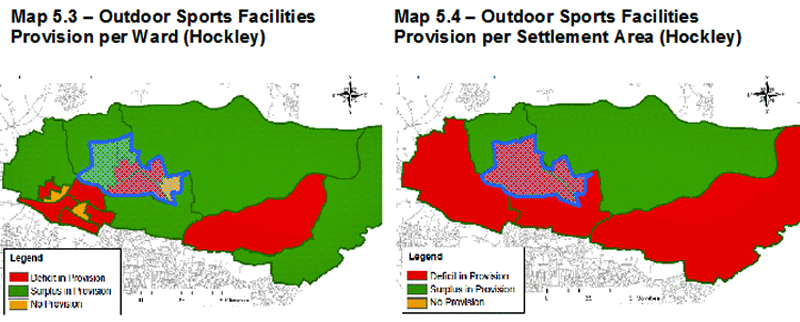
Findings for the Hullbridge Sub-Area
5.43 Three football clubs and one cricket club based in Hullbridge returned the questionnaire.
Quality of the playing pitches and ancillary facilities
5.44 Lack of appropriate local facilities such as floodlit and Astroturf pitches was the only issue raised by one of the football clubs.
5.45 Other football clubs believed that lack of funding (internal and external) is a problem and one club also suggested there is lack of assistance to support such a large facility.
5.46 One cricket team playing in Hullbridge Sports and Social Club requested an upgrade of facilities to the required level.
Availability and bookings
5.47 According to the Playing Pitch Model (PPM), only Hullbridge has no surplus or deficit on mini soccer pitches in 2008. However, like all other settlements, Hullbridge experiences a shortage in junior football pitches on Sundays AM and PM.
5.48 From the information received, none of the clubs in Hullbridge play outside the settlement.
Accessibility
5.49 No comments have been received in relation to accessibility in Hullbridge.
Access to other outdoor sports facilities
5.50 According to the Open Space Study, there are seven outdoor sports facilities in Hullbridge which include three football fields, three yacht clubs and a golf club.
5.51 The two maps below show the same boundary of Hullbridge as a ward and settlement. Hullbridge is one of the two settlement areas in the District showing a surplus in provision.
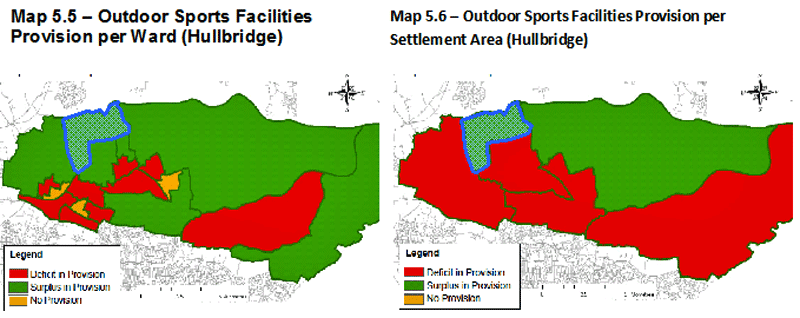
Findings for the Rochford Sub-Area
5.52 Ten questionnaires were received from nine football clubs and one hockey club in Rochford.
Quality of the playing pitches and ancillary facilities
5.53 Two football fields in Rochford were rated more than once as one of top three pitches in 2008 (Q.17). Ashingdon Recreation Ground was selected as one of the best three in five responses, while Rochford Recreation Ground at Doggetts Close, Stambridge was selected three times.
5.54 Notwithstanding this, Ashingdon Recreation Ground was also identified three times in response to the question “what are the three worst pitches you have played on this season”. This may indicate a variation in quality of pitches on the same field.
5.55 One football club located in Rayleigh but playing their home games in Rocheway has made a comment regarding the ancillary facilities. They pointed out that their main concern is a lack of storage space for match day equipment – managers have to hand over the equipment to each other every Saturday at training.
5.56 One football club playing in various locations in Rochford pointed out that the facilities and ground maintenance are poor: goal posts skewed and damaged, infrequent grass cutting, potholes not being fixed, etc. The club also believed that while the Council pass the responsibility to pitch providers, pitch providers pass the matter back to the Council. Moreover, there was lack of information on changeover of pitch providers. Further comments received are included in the Availability and Bookings section.
5.57 One women’s football team based in Ashingdon believed that facilities at pitches are limited and poor. Further comments received are addressed in the next section.
Availability and bookings
5.58 At the local demand/ supply level, all of the undersupply for mini and junior football pitches falls on Sundays AM and both AM and PM respectively; conversely there is a surplus on senior pitches on both Sundays AM and PM.
5.59 Some football clubs made comments with regard to availability and bookings. All shared the same viewpoint that there is very little information available as how and where pitches can be hired from and what is available. In addition, responses from football clubs have also shown that they consider pitches are expensive to hire.
5.60 Two third of the clubs who replied to the questionnaire has either put down ‘none’ or ‘n/a’ for their training venue; two put down any available open public space; and only one club was had outdoor training in the Rochford area. Another club who were based outside the District were having their indoor training sessions at King Edmunds School.
5.61 Two clubs that train outside the District are playing in Leigh-on-Sea and Basildon.
5.62 One of the respondents stated that the football club can only do a short season due to facilities being changed over to cricket, hence they cannot always fulfil home fixtures.
5.63 These responses received appear to imply a significant shortage of playing pitches in the Rochford area, several clubs do not have a regular dedicated training ground and are merely able to secure a pitch on the match day. The demand for pitches echoed that shown in the current PPM.
5.64 Despite the current PPM identifying a surplus of one hockey pitch, the hockey club claimed that there is a shortage of hockey pitches across the District.
5.65 As King Edmund School is the only hockey pitch provider in the District, it is important for the Council to encourage the sign up of a formal community use arrangement to secure the public use of the pitch.
Accessibility
5.66 In Question 4 of the questionnaire, clubs put down which town the majority of their players reside, only half of the clubs based in Rochford stated considered their players are from Rochford/Ashingdon, whilst one believed the majority of their players live in Wickford/ Basildon.
5.67 One football club whose players are mainly from Southend notes that they would consider relocation to different premises only if there is an ideal opportunity and/or if there is any problem with leasehold ownership of the pitches.
5.68 Due to the high quality of pitches available in Rochford and the close proximity to other administration area i.e Southend, there seemed to be an imbalance with teams situated within Rochford but playing elsewhere and teams outside the District but playing in Rochford.
Access to other outdoor sports facilities
5.69 There is a good mixture of outdoor sports facilities in Rochford. The Open Space Study has identified 13 outdoor sports facilities in Rochford, Ashingdon and Canewdon, which are all classified as within the Rochford settlement area in the Playing Pitch Strategy. Among those, there are six football fields, two tennis clubs and golf clubs, a rugby club and a yacht club.
5.70 Map 5.7 indicates that there are sufficient outdoor sports facilities within the Ashingdon and Canewdon area.
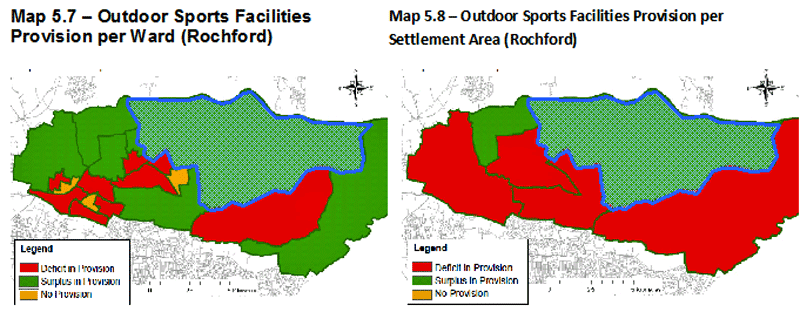
Findings for the Great Wakering Sub-Area
5.71 Six questionnaires were received from football clubs based in Great Wakering.
Quality of the playing pitches and ancillary facilities
5.72 Cupids Country Club and Great Wakering Recreation Ground in Great Wakering were identified seven times and five times, respectively, as one of the top three pitches in 2008 by those football clubs who replied to the questionnaire.
5.73 A football club playing their home games in Cupids Country Club was very positive with the pitch as well as the facilities.
5.74 Another club playing in Cupids was pleased with the facilities in general but considered that costs for pitch hire was an issue for them.
5.75 The football club playing in Great Wakering Recreation Ground was positive about the management of the pitch, but was disappointed with the ancillary facilities e.g. goal nets, which were considered to be all extremely poor and have not been replaced for at least six seasons (before 2008). In addition, one football club stated that they were ineligible for promotion due to being unable to meet facility requirements set by the Football Association.
Availability and bookings
5.76 Similar to all other settlements in the District, all of the undersupply for mini and junior football pitches falls on Sundays AM and both AM and PM, respectively; but there is a surplus of senior pitches on Sundays AM and PM.
5.77 Only three clubs answered the question relating to whether they travel outside the settlement for training sessions. All three clubs trained within the settlement. However only one club did all their training within Great Wakering while the other two clubs stated that they were also have some of their training sessions either outside the settlement area or outside the District, in Hockley and Leigh-on-Sea respectively.
Accessibility
5.78 It was asked in the questionnaire where the majority of the team players reside. All the clubs that replied consider that their players are mainly from Southend, Rochford, Hockley, Rayleigh, with the exception of one club that stated their players mainly reside in Wickford and Basildon. None considered the majority of their players to be from Great Wakering however.
5.79 Like Rochford, there seemed to be an imbalance with teams situated within Great Wakering playing elsewhere.
Access to other outdoor sports facilities
5.80 The Open Spaces Study has identified seven outdoor sports facilities in Great Wakering. There are three football pitches, a cricket pitch, a bowling green, a yacht club and a sailing club.
5.81 Map 5.9 shows that outdoor sports facilities provision in the Barling and Sutton ward is in deficit, while the Great Wakering and Foulness is in surplus. Map 5.10 shows that the outdoor sports facilities provision in the settlement is in deficit in general terms.
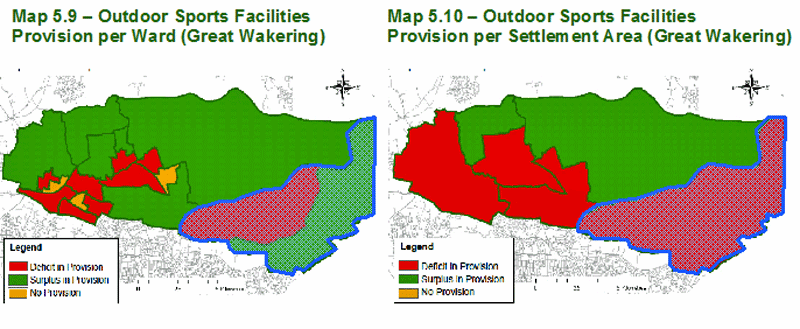
School Questionnaire Findings
5.82 As mentioned in Chapters 3 and 4, it is important to secure playing pitches for community use. Major pitch providers include local authority, voluntary and private sector and schools.
5.83 Schools are important potential pitch providers. All schools have at least one grass field, so if they were to open up some pitches for the community to use, this would undoubtedly ease the pressure for football pitches as well as other sports facilities in the District.
5.84 Of the schools that responded, only two confirmed that they have signed up for a formal community use arrangements.
5.85 Notwithstanding this, eight more schools have shown an interest and would consider opening up their pitch facilities for community use in the future.
5.86 A minimum of 12 football pitches (from mini to adult), four rugby pitches (junior and adult), four artificial wicket cricket pitches, two hockey pitches, two artificial turf pitches and 10 generic grass field can be secured for public use if a formal community use agreement is endorsed.
